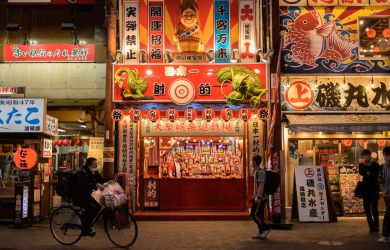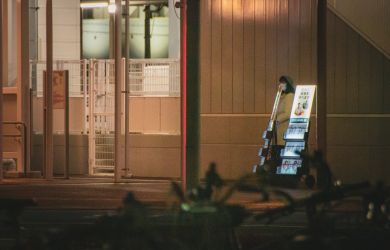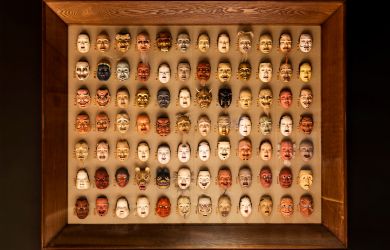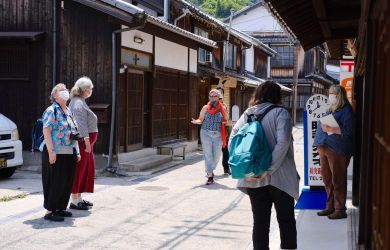
March 3, 2011
Following the True Path
For hundreds of years, the Shoninki has served as an inspiration for aspiring ninja. Now the work finally sees the light of day in English
By Metropolis
Originally published on metropolis.co.jp on March 2011
 The classic ninja training manual known as Shoninki has a history as colorful as the furtive agents it was meant to instruct. Originally written in the 17th century, on a now-lost scroll, the book offers tips on everything from the art of camouflage to “reading someone’s character by his face” to recipes for self-defense that include using burnt frogspawn as a blinding agent. On March 1, Tuttle Publishing released what is being described as the first authoritative translation of the Shoninki in English (see sidebar). In these exclusive excerpts, we learn the importance of recruiting local spies, tips on self-concealment—and the advantages of stealing drinking cups. ST
The classic ninja training manual known as Shoninki has a history as colorful as the furtive agents it was meant to instruct. Originally written in the 17th century, on a now-lost scroll, the book offers tips on everything from the art of camouflage to “reading someone’s character by his face” to recipes for self-defense that include using burnt frogspawn as a blinding agent. On March 1, Tuttle Publishing released what is being described as the first authoritative translation of the Shoninki in English (see sidebar). In these exclusive excerpts, we learn the importance of recruiting local spies, tips on self-concealment—and the advantages of stealing drinking cups. ST
From Part I
GOKAN 五間 THE FIVE TYPES OF SPY
Inko no kan 因口の間 Local Spies
Their purpose is to gather information and to achieve their goals by utilizing the local dialects. It is the same as the Japanese skill of Dakko 奪口, which literally means “ripping off the mouth” and is the method of spying, deceiving, or gathering information by having a good command of the local dialect.
Nairyo no kan 内良の間 Inward Spies
This refers to the method of secretly tempting an enemy retainer or someone who is close to the enemy and utilizing them for one’s own benefits. However, to do this, you need to prepare them years beforehand and with utmost care, managing and controlling them before they are actually needed.
Hantoku no kan 反徳の間 Converted Spies
This refers to getting hold of the enemy’s shinobi and using them for your own purposes. With their cooperation you can obtain remarkably outstanding information. You can use the enemy’s shinobi who have been sent to spy on you, by feeding them false information, thus allowing them to falsely report back to your enemy.
Shicho no kan 死長の間 “Doomed Spies” or “Those who are expendable”
It is said you should reward them liberally and they will work to bring about critical benefits for your army’s need.
Tensei no kan 天生の間 Surviving Spies
This refers to spies who are good at espionage and spying by infiltrating enemy lines.
From Part I
THE SEVEN TYPES OF DISGUISE A NINJA SHOULD USE
1. Komuso Zen monks 虚無僧: you will be able to wear the straw Amigasa hat in this get-up, which as mentioned before will give you good visibility while hiding your face.
2. Shukke monks 出家: this is an easy approach for both men and women to use.
3. Yamabushi mountain priests 山伏: this is an easy approach for both men or women to use and they can carry a katana or wakizashi short-sword without being questioned.
4. A merchant: This makes it easy to approach people.
5. Hokashi street entertainers 放下師: This will make it easy to approach people, as they commonly do street entertainment and people are used to them traveling.
6. Sarugaku performers 猿楽: As a form of theater, people will not question why you are there.
7. Tsune no katachi or street clothes 常の形: You should dress in accordance to the type of person you wish to emulate and that will be found on the streets that you wish to travel along.
From Part II
“A story”
A shi 師 or master told his good disciples to steal a large pot from a shop. However, they couldn’t steal such a huge bottle during the daytime without getting caught. Then the master showed them how to take it in a true shinobi fashion. He went to the shop and simply purchased it. All his disciples laughed to see this. The master said the following about this lesson: “That’s exactly why you are not skilled. Your intention was to take the bottle directly, which makes you see nothing but the object itself. I first stole ten or so small drinking cups within my reach and hid them within my sleeves. I did this earlier on in the day. I got enough money by selling them that I bought the jar with that money, thus I stole the jar. This is how to change your approach as a true shinobi.”
From Part II
“Appropriate times to creep in”
The best times at night for this are around dusk, the hours of the Boar 亥 (9-11pm), of the Rat 子 (11pm-1am), and of the Tiger 寅 (3-5am).
In the daytime, the optimum times are of the Hare 卯 (5-7am), of the Horse 午 (11am-1pm), and of the Cock 酉 (5-7pm).
If you don’t know what time it is, it is possible for some people to tell the time by their body. When you breathe more through your left nostril, then the time will be of an even number, and if the right, then it will be an odd number.
Even the iris of a cat’s eye is changeable according to the time of day. This is even more so with humans, thus the closer to midday you get then the narrower the eyes will be.
If someone is truly asleep, his breathing will be irregular, and you can discover if someone is feigning sleep if there is too much regularity to their breathing. It is also said people stir every two hours after they have fallen asleep.
 True Path of the Ninja: The Definitive Translation of the Shoninki, by Antony Cummins and Yoshie Minami (Tuttle, 2011) is available at bookstores or via Amazon for $14.95. Excerpts reprinted with kind permission of the publisher
True Path of the Ninja: The Definitive Translation of the Shoninki, by Antony Cummins and Yoshie Minami (Tuttle, 2011) is available at bookstores or via Amazon for $14.95. Excerpts reprinted with kind permission of the publisher
Digging deep
How a foreigner helped unearth one of Japan’s most celebrated texts
By Ross Davies
 When Metropolis last spoke with Antony Cummins in 2009, he was in Tokyo to promote True English, a down-in-the-gutter phrasebook for Japanese learners. Since then, he has been hard at work on a rather different project: investigating Japan’s ancient ninja history. The result is True Path of the Ninja—the first definitive English-language translation of the 17th-century Shoninki training manual.
When Metropolis last spoke with Antony Cummins in 2009, he was in Tokyo to promote True English, a down-in-the-gutter phrasebook for Japanese learners. Since then, he has been hard at work on a rather different project: investigating Japan’s ancient ninja history. The result is True Path of the Ninja—the first definitive English-language translation of the 17th-century Shoninki training manual.
Cummins’ quest to translate the ancient manuscript has taken him from his native UK to Tokyo and Hiroshima, collecting information from luminaries in the ninja field. So, where did this obsession with all things ninja begin?
“I was a product of the ninja boom of the 1970s and 1980s, when there were a number of films depicting this strange and mystical art,” he says. “Later, I realized that they were purely Hollywood depictions, so I began reading historical accounts in a bid to learn more on what the true life of a ninja entailed.”
The Shoninki, a revered and mystical tome whose original 1681 scroll is long lost to history, first came to Cummins’ attention in 2008. With the “invaluable help” of translator Yoshie Minami, he managed to locate one edition of the text—thought to be a 1743 transcription of the original manuscript—in Japan’s National Diet Library. But procuring it came at a price.
“I forked out roughly ¥67,000 for the text, including recent notes by Dr. Nakashima Atsumi, a ninja historian,” Cummins recalls. “To gain a better understanding, I flew to Hiroshima to spend a few days with Dr. Atsumi (pictured, right) in the Chugoku Mountains, where we worked closely on determining the true meaning of the script.”
Armed with new information, Cummins next headed to Chiba to meet Risuke Otake, the celebrated teaching master (now retired) of Tenshin Katori Shinto-Ryu, one of Japan’s oldest swordsmanship schools. Otake, who provides the book’s foreword, allowed Cummins the sacrosanct privilege of hearing the script through the ancient ninja oral tradition—a 500-year-old lineage.
“It was certainly a humbling experience to be in the presence of one of the greatest sword masters of all time,” the author says. “We sat in his house, dotted with plates of armor and scrolls hanging from the walls, whilst he also told us the incredible story of how he began ninja swordsmanship during the Second World War in preparation for the ancient act of dying for his country.”
Despite the notable feat of translating the Shoninki, Cummins—himself a trained martial artist—has come to be seen as a dividing force in the international martial arts community, thanks to his belief that ninjutsu is an ancient form of Japanese espionage, as opposed to the combative martial arts taught today. To the casual observer, the differences may seem small, but according to Cummins, the debate remains enormously contentious.
“I find it a shame that so many supposed ninja dojos have become profit-led conglomerates, whilst [failing] to remain true to the ancient art,” he says. “I hope this translation provides an insight into what life as a ninja was really like.”





